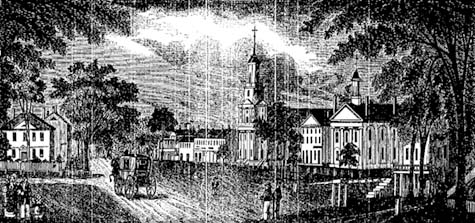NorthamptonExtracted and edited from “History And Antiquities of Every Town In Massachusetts” by John Warner Barber, 1848.
 Central Part of Northampton, Mass.
The view shows the appearance of the Court-House, the First Congregational Church, and other buildings, as seen from the road in a north-eastern direction. The Congregational Church is the building seen in the central part of the engraving. The Indian name of Northampton was Nonotuck. It formerly included Southampton, Westhampton, and Easthampton, since incorporated as towns. The fertility, extent, and beauty of the fine intervals in this region attracted the attention of settlers at an early period. The township was purchased in 1653, and conveyed to John Pynchon, Esq., for the planters, by Wawhillowa, Nenessahalant, Nassicohee, and four others, (one of whom was a married woman,) styled “the chief and proper owners,” for one hundred fathom of wampum by tale, and ten coats, besides some small gifts, in hand paid to the sachems and owners, and also for ploughing up sixteen acres of land on the east side of Quonnecticut river the ensuing summer. These “all bargained for themselves, and the other owners by their consent.” The original planters were twenty-one in number, and the legal grant was made to them in 1654, by “John Pynchon, Elizur Holyoke, and Samuel Chapin, commissioners for laying out Nonotuck, by the general court,” and the settlement of the town commenced the same year.1 In 1656, “towns men” (or selectmen) were chosen, and in 1657 three commissioners were chosen at a town meeting “as a court to end small causes.” The same year, the town employed an agent “to obtain a minister, and to devise means to prevent the excess of liquors and cider from coming to the town.” In 1662, at the formation of the county of Hampshire, consisting of the three towns of Springfield, Northampton, and Hadley, Northampton was made a half shire, and in 1794 was made the county town. The village of Northampton is situated about a mile from Connecticut river, a little elevated above the surrounding meadows. These meadows are some of the best land in New England, and are in the highest state of cultivation. The village, although very irregularly laid out,2 is one of the most beautiful and best built villages in New England. Situated in the delightful valley of the Connecticut, surrounded with beautiful and variegated prospects on every side, with the magnificent front of Mount Holyoke, rising to the height of 830 feet, on the opposite side of the river, the scenery of this place presents a specimen of the “sublime and beautiful.” A fine stream passes the center of the town, possessing a good water power, on which are mills and factories of various kinds. This place has considerable river and inland commerce, which will probably be increased by the New Haven and Northampton canal, which terminates a little north of the village. 1 There is a tradition that one English family came to Northampton in 1652, and lived on land which is east of what is now called Hawley street.
2 It has been said that they [the streets] were laid out by the cows, and that wherever these animals, when going to feed in the forests, made their paths, the inhabitants located their streets. The probability is, that the first planters, being both inclined and obliged to build near to each other, placed their houses wherever the ground was sufficiently dry to furnish convenient building spots.” — Dr. Dwight’s Travels, volume i., page 328.
| Northampton|
| History And Antiquities of Every Town In Massachusetts | | Hampshire County | | Western Mass History & Genealogy |
These pages are an edited and adapted version of the original
and cannot be reproduced in any format without permission © Laurel O’Donnell, 2006, all rights reserved This page was last updated on 28 Apr 2006 |

